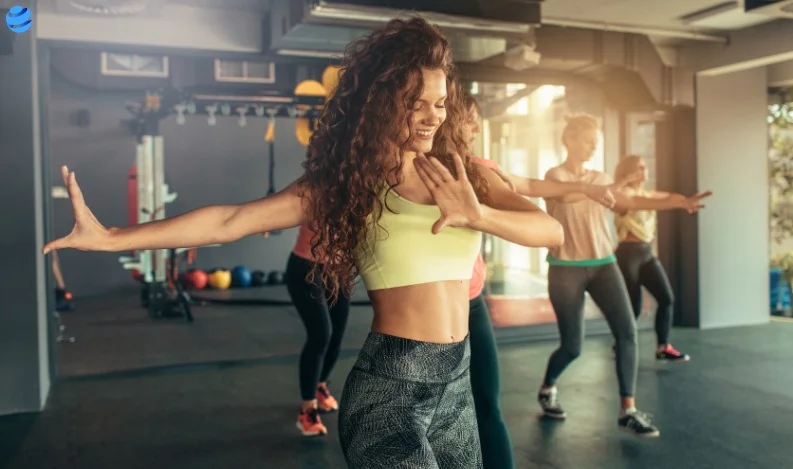Fitness is an ever-evolving field, and each year brings new trends and shifts in what’s popular. In 2024, the fitness landscape is marked by some exciting innovations and a few fading trends. This comprehensive guide will explore the current trends shaping the fitness world and highlight the practices that are falling out of
What’s In: Popular Fitness Trends
1. Home Workouts
Convenience and Flexibility
Home workouts are one of the standout trends of 2024. The rise in remote work and flexible lifestyles has led many people to prefer exercising at home. This trend offers a high degree of convenience. With home workouts, there is no need to commute to a gym or adhere to specific class schedules. You can work out whenever it fits your schedule, making it easier to maintain a consistent exercise routine.
Cost-Effectiveness
Another appealing aspect of home workouts is their cost-effectiveness. You don’t need to invest in an expensive gym membership or fancy equipment. Bodyweight exercises, such as push-ups, squats, and lunges, can provide an effective workout without any cost. Additionally, many online resources offer free workout videos and routines, allowing you to access high-quality fitness instruction without spending a dime.
Variety and Accessibility
Home workouts also offer a variety of exercise options. You can choose from yoga, pilates, high-intensity interval training (HIIT), and more. With so many online platforms available, you can easily find workouts that suit your fitness level and preferences. This variety helps keep exercise routines fresh and engaging, reducing the likelihood of boredom and helping you stay motivated.
2. Wearable Fitness Technology
Tracking and Motivation
Wearable fitness technology continues to gain popularity in 2024. Devices such as smartwatches and fitness trackers are now more advanced than ever. These gadgets offer real-time tracking of various fitness metrics, including steps taken, heart rate, and even sleep quality. By providing detailed insights into your daily activity, these devices help you stay motivated and make informed decisions about your fitness routine.
Data-Driven Insights
The data collected by wearable technology can also help you understand your fitness progress over time. Many devices come with accompanying apps that offer in-depth analysis and personalised recommendations. For example, if you notice that your heart rate tends to spike during certain activities, you can adjust your workouts to better manage your cardiovascular health. This data-driven approach helps optimise your fitness routine and achieve your goals more efficiently.
Integration with Other Health Metrics
Wearable technology is not limited to just tracking physical activity. Many modern devices also monitor other health metrics, such as stress levels, hydration, and even blood oxygen levels. This comprehensive view of your overall health enables you to make more holistic lifestyle changes and improve your well-being in multiple aspects.
3. Group Fitness Classes
Social Interaction and Community
Group fitness classes remain a popular trend in 2024. People enjoy the social aspect of working out with others. Classes such as Zumba, spinning, and boot camp offer a sense of community and camaraderie. This social interaction can make workouts more enjoyable and provide a strong sense of accountability.
Motivation and Fun
The energy and enthusiasm of a group setting can also boost motivation. Many people find that exercising with others is more fun and engaging than working out alone. Group classes often include music, dynamic instructors, and a structured format that keeps participants excited and committed to their fitness goals.
Varied Formats and Specialisations
Group fitness classes come in many different formats, catering to a wide range of interests and fitness levels. From high-intensity interval training (HIIT) to yoga and Pilates, there’s a class for everyone. This variety allows participants to explore different types of workouts and find the ones that best suit their preferences and goals.
4. Mindfulness and Meditation
Stress Reduction and Mental Clarity
Mindfulness and meditation are gaining traction as essential components of fitness in 2024. These practices focus on mental well-being and stress reduction. Meditation helps calm the mind, improve focus, and enhance overall emotional health. Incorporating mindfulness into your fitness routine can lead to better stress management and a more balanced lifestyle.
Holistic Approach to Health
The integration of mindfulness and meditation into fitness reflects a growing understanding of the connection between mental and physical health. Many people are recognising that true well-being involves more than just physical fitness; it also requires mental and emotional balance. Mindfulness practices can complement physical exercise by promoting relaxation and enhancing your overall quality of life.
Accessible Practices
Mindfulness and meditation are accessible to everyone, regardless of fitness level or experience. You can practise these techniques at home, in a class, or even during breaks at work. There are also numerous apps and online resources available to guide you through meditation sessions and mindfulness exercises, making it easier to incorporate these practices into your daily routine.
5. Functional Fitness
Practical Benefits
Functional fitness is a trend that focuses on exercises that mimic everyday movements. These exercises, such as squatting, lifting, and twisting, help improve your ability to perform daily activities with ease. Functional fitness routines are designed to enhance your overall strength, flexibility, and balance, making them highly practical for real-life situations.
Injury Prevention and Rehabilitation
Functional fitness can also play a role in injury prevention and rehabilitation. By strengthening the muscles and joints used in daily activities, functional exercises can help reduce the risk of injuries and improve recovery times. This approach to fitness is beneficial for people of all ages, including those recovering from injuries or managing chronic conditions.
Variety and Adaptability
Functional fitness routines can be easily adapted to different fitness levels and goals. Whether you’re a beginner or an advanced athlete, you can customise your functional fitness workouts to match your needs. This adaptability makes functional fitness a versatile and effective option for a wide range of individuals.
What’s Out: Fitness Trends That Are Fading
1. Extreme Fitness Challenges
High Risk of Injury
Extreme fitness challenges have seen a decline in popularity. These intense and demanding workouts can put significant strain on the body. The risk of injury is higher with extreme challenges, as they often involve high-impact movements and strenuous exercises. Many people are now opting for more balanced and sustainable fitness routines that prioritise safety and long-term health.
Difficulty in Maintaining
Another reason for the decline of extreme fitness challenges is their difficulty in maintaining over time. These challenges often require a high level of commitment and can be difficult to sustain as part of a regular fitness routine. Many individuals prefer routines that are easier to integrate into their daily lives and can be maintained over the long term.
Shift Towards Balanced Approaches
As the fitness community shifts towards more balanced approaches, there is a growing emphasis on overall well-being rather than extreme performance. People are increasingly seeking workouts that promote health, enjoyment, and sustainability, rather than pushing their bodies to the limit.
2. Strict Diets
Unrealistic Restrictions
Strict diets are becoming less popular as more people recognise their limitations. Highly restrictive diets often involve cutting out entire food groups or imposing rigid rules. These approaches can be difficult to maintain and may lead to feelings of deprivation. Instead, many individuals are moving towards more flexible and balanced eating habits.
Focus on Healthy Eating
The trend is shifting towards a focus on healthy eating rather than strict dietary rules. People are embracing a more intuitive approach to nutrition, emphasising whole, nutrient-dense foods and listening to their bodies’ hunger and fullness cues. This balanced approach supports long-term health and well-being without the stress of rigid diet plans.
Emphasis on Enjoyment and Sustainability
Many people are now prioritising enjoyment and sustainability in their eating habits. Instead of adhering to strict diets, they are focusing on making healthy food choices that they can maintain over time. This approach helps foster a positive relationship with food and encourages lifelong healthy eating habits.
3. Solo Workouts
Lack of Motivation and Engagement
Solo workouts are seeing a decline in popularity. Exercising alone can sometimes lead to a lack of motivation and engagement. Without the energy and support of a group or class, it can be challenging to stay committed to a fitness routine. Many people are finding that group settings and social interactions enhance their workout experience.
Social and Community Benefits
Group workouts offer social and community benefits that solo workouts may lack. Working out with others can provide a sense of camaraderie and accountability, making it easier to stay motivated and committed. The social aspect of group fitness classes can also make exercising more enjoyable and fulfilling.
Rise of Collaborative Fitness Experiences
As the trend moves away from solo workouts, there is a rise in collaborative fitness experiences. People are seeking opportunities to connect with others through shared fitness activities, whether it’s group classes, sports teams, or community fitness events. These experiences foster a sense of belonging and enhance the overall fitness journey.
4. Fancy Gym Equipment
High Costs and Maintenance
Fancy gym equipment is falling out of favour due to its high cost and maintenance requirements. Expensive machines and specialised equipment can be costly to purchase and maintain. Many people are choosing more cost-effective and versatile workout options that do not require elaborate gear.
Simplicity and Effectiveness
The trend is moving towards simplicity and effectiveness in fitness equipment. Bodyweight exercises, resistance bands, and free weights are becoming more popular as they offer a wide range of workout possibilities without the need for complex machinery. These simple tools are effective and can be used to achieve a variety of fitness goals.
Emphasis on Functional Training
There is also a growing emphasis on functional training, which focuses on exercises that mimic everyday movements. Functional training often requires minimal equipment and can be performed using bodyweight exercises or basic tools. This approach prioritises practical and functional fitness over the use of fancy gym equipment.
5. Overemphasis on Physical Appearance
Shifting Focus to Health and Wellness
The overemphasis on physical appearance is declining as the focus shifts to overall health and wellness. People are increasingly recognising that fitness is about more than just looking good; it’s about feeling good and maintaining a healthy lifestyle. This shift reflects a broader understanding of fitness as a holistic pursuit that encompasses physical, mental, and emotional well-being.
Promoting Positive Body Image
There is a growing movement towards promoting positive body image and self-acceptance. Instead of striving for a specific appearance, individuals are encouraged to appreciate their bodies for what they can do and how they feel. This approach fosters a healthier relationship with fitness and encourages a more inclusive and supportive fitness community.
Emphasis on Well-Being
The focus on well-being encompasses not only physical fitness but also mental and emotional health. Fitness routines that prioritise overall well-being are gaining popularity. Activities such as mindfulness, stress management, and self-care are being integrated into fitness practices to support a balanced and fulfilling lifestyle.
Conclusion
As we explore the fitness trends of 2024, it’s clear that the landscape is evolving in exciting ways. Home workouts, wearable technology, group fitness classes, mindfulness, and functional fitness are leading the way in this year’s fitness scene. Meanwhile, extreme fitness challenges, strict diets, solo workouts, fancy equipment, and an overemphasis on physical appearance are fading from the spotlight.
Staying updated with fitness trends can help you make informed decisions about your health and well-being. Whether you’re looking to enhance your workout routine, embrace new technologies, or adopt a more balanced approach to fitness, understanding these trends can guide you in making choices that best suit your lifestyle and goals. Remember, fitness is a personal journey, and finding what works for you is the key to achieving long-term success and enjoyment in your fitness pursuits.
You may also like:-













